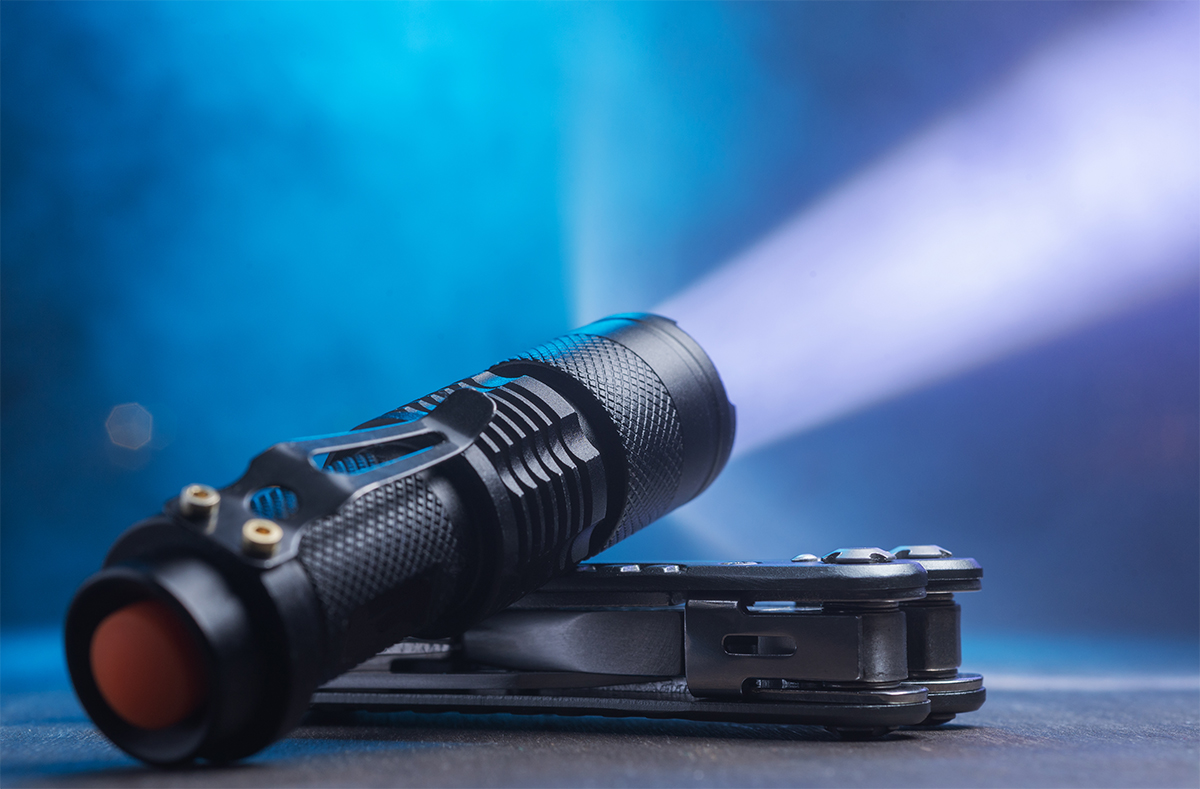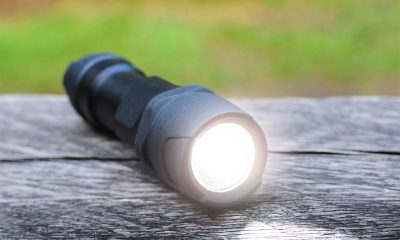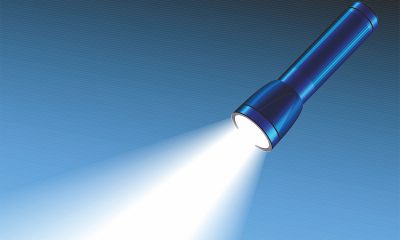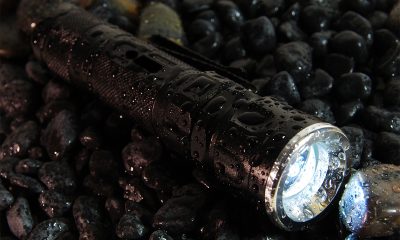What is a tactical flashlight
A tactical flashlight is a handheld or weapon-mounted torch designed to help tactical personnel carry out their duties. When used properly, it can heighten tactical effectiveness in threat identification, target acquisition, visual impairment, and surviving in a ground fight. The defensive light typically produces a blast of blinding white light that can negate penalties for darkness within their illuminated areas, temporarily overwhelm the dark-adapted vision of an attacker and enhance the user’s ability to identify and engage a target. A tactical flashlight is designed and engineered to provide powerful, dependable, and conveniently available illumination that will not fail you when you need it. Cutting-edge LED technology is packed into the light to deliver performance, robustness and reliability that cater to military, police, security and law enforcement professionals. Tactical flashlights are also used by civilians to aid in personal self-defense and emergency assistance.
Beam performance
Tactical flashlights are high intensity spotlights that can throw a focused beam to illuminate far distances with ease. These lights come in lumen packages ranging from hundreds to thousands and up to tens of thousands. Lumen output is important for a tactical flashlight, but it is far less valuable if the majority of the optical power isn’t striking the target. Whatever the amount of lumens they pump out, the emitted light is generally collimated as much as possible to create maximal center beam candlepower (CBCP) at the farthest possible distance. The intense beam packs enough of a punch which penetrates the darkness and momentarily disorients the adversary to gain a crucial tactical advantage. The ability to create a very punchy beams is attributed to the use of LEDs, which can operate with high flux density to enable tight beam control for high center beam intensity and uniformity in directional and high lumen applications. Because of the small size and directionality of LEDs, virtually every lumen produced by the light source can be extracted and distributed for forward light throw. In tactical flashlights, optical regulation is provided by a precision molded reflector or a total internal reflection (TIR). The latter combines the best of both a reflector and a lens to create very tight beams with FWHM divergence as small as 3 degrees. Some LED Flashlights feature a zoom function. The beam can be changed from spot distribution to flood distribution with a simple twist or push/pull slide of the head.
Light source
Tactical flashlights exclusively capitalize on high power LED packages to produce blinding beams of white light. LEDs emit light through intracrystalline recombination of holes and electrons in the direct band gap semiconductors. The recombination of the charge carriers results in energy being emitted in the form of electromagnetic waves with a narrow wavelength band in the visible range of the spectrum. A phosphor wavelength converter partially or completely converts the electroluminescence (narrow spectrum electromagnetic waves) to create the desired white light.
High power LED packages have a robust architecture that provides a thermal path conductive enough to remove the heat from the LED die to ensure it doesn’t overheat while the package materials are selected to withstand high thermal stresses. Effective thermal design and high package reliability make it possible for the LEDs to operate with high efficacy, high lumen output and superior lumen maintenance at high drive currents.
At present the majority of the high power LEDs are ceramic packages that attach the LED chip to a metallized ceramic substrate. Cree has definitely earned the brightest spot in the industry. The footprint of Cree high power LEDs can be found in countless flashlights. Adoption of the industry-leading SiC substrate technology results in a very low density of intracrystalline defects (threading dislocations), enabling a high level of performance and reliability in high power LED applications that are not possible with GaN-on-sapphire and GaN-on-silicon LEDs.
Chip-scale package (CSP) LEDs with lower thermal resistance than conventional LEDs are expected to take significant market share in the future. The high power LEDs used in a tactical flashlight typically carry a cool white tone or a correlated color temperature (CCT) greater than 5000K, which is intended to create a high psychological impact for maximal tactical effectiveness.
Thermal management
The high power LEDs are pre-assembled on a metal core printed circuit board (MCPCB) before they are incorporated into a flashlight. The MCPCB provides the LEDs with mechanical support and electrical connections through solder joints. The formation of a reliable solder joint between the LED package and printed circuit board is very critical in tactical applications because the flashlights are often subjected to drops and mechanical impacts associated with ground fighting and fast-paced activities. The MCPCB also assists with heat dissipation by spreading the LED heat flux over a larger area to help improve thermal transfer into a heat sink.
The LED assembly is fixed to the heat sink to complete the thermal path of the LED system. The heat sink is fabricated from a high thermal conductivity material which is commonly aluminum. Channels, fins or other geometries may be built into the heat sink to maximize convective surface area. A thermal interface material (TIM) may be sandwiched between the PCB and heat sink to minimize the interfacial contact resistance. The more efficient the heat transfer from the LED junction to the surrounding air, the better and longer the LED flashlight will function.
Intensity control
LEDs operate to specification over a rated life only when they are driven with a forward voltage of sufficient magnitude and the DC power delivered to the LED packages is appropriately regulated. In an LED flashlight, the power discharged by the batteries must be processed by an LED driver before it is provided to the LED load. In addition to provide voltage and current regulation, the driver determines the controllability of the LEDs. Most tactical flashlights allow stepped dimming or infinitely variable brightness adjustment. This function is performed by a dimmable LED driver. The driver can interpret control signals given out by a microcontroller to dim the emitted light or operate the light in tactical defense strobe (TDS) mode for signaling/disorienting. The user interface is typically comprised of a tactical tail switch and a side switch. The tactical light is activated via the tail switch. The side switch allows the user to choose between different modes of light output.
Battery, charge control and protection circuitry
Both primary and secondary (rechargeable) batteries are used to power tactical flashlights. Rechargeable lithium batteries have emerged as the technology of choice. These batteries make use of a lithiated metal oxide or lithium metal phosphate cathode and a carbon anode to form dual intercalation electrochemical systems that provide high density energy storage. Lithium-ion batteries can be discharged down as much as 80%, which means more electrical energy can be extracted during operation. Repeated deep cycling has a minimal adverse effect on the battery cycle life. Additionally, lithium-ion batteries have a relatively low self-discharge rate and high charging efficiency.
Battery management systems, however, must be used with lithium-ion rechargeable batteries to monitor battery voltage and temperature, control the charge and discharge currents, and protect the individual cells from electrical abuse. The 18650 is the most used type of lithium-ion batteries for flashlights that run on rechargeable batteries. Other battery types include14500, 16340, 21700, etc. Aside from using rechargeable batteries, the disposable CR123A lithium batteries are hugely popular for use in non-rechargeable systems.
Construction and external features
Ruggedness is also one of the core signatures of a tactical flashlight. A tactical flashlight has a weather resistant, virtually indestructible construction that withstands the rigors of tough duty and extreme conditions. The high strength, crush proof housing is crafted from aerospace grade aluminum alloy and anodized against corrosion inside and out. Aggressive knurling pattern on the body provides a secure grip. The luminaire is often sealed throughout for a high watertight integrity. The lighthead of a tactical flashlight may have a serrated edge or ridges on the bevel, which allows the flashlight to be used as an improvised weapon during ground fighting. The tactical function of a flashlight is enhanced when equipped with tactical rings, gun mounts and remote switches.

















Loading...